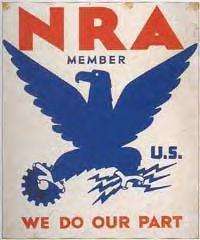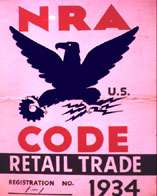Blue Eagle

The Blue Eagle was a symbol used in the United States by companies to show compliance with the National Industrial Recovery Act, a part of President Franklin Roosevelt's "New Deal" program. The NIRA authorized the creation of the NRA (National Recovery Administration), which was used to exercise control over business and industry, focusing on regulations and price controls, and was later found to be unconstitutional.
The blue eagle was proclaimed the symbol of industrial recovery on July 20, 1933 by Hugh S. Johnson, the head of the National Recovery Administration.[1][2][3]
Design
Many sources credit advertising art director Charles T. Coiner with the design.[4][5][6][7] According to a few sources, however, it was sketched by Johnson, based on an idea used by the War Industries Board during World War I.[1][3] The eagle holds a gear, symbolizing industry, in its right talon, and bolts of lightning in its left talon, symbolizing power.[8]

Use as a symbol
All companies that accepted President Franklin D. Roosevelt's Re-employment Agreement or a special Code of Fair Competition were permitted to display a poster showing the Blue Eagle together with the announcement, "NRA Member. We Do Our Part."[1][2][3] Consumers were exhorted to buy products and services only from companies displaying the Blue Eagle banner.[1][3] According to Johnson,
When every American housewife understands that the Blue Eagle on everything that she permits into her home is a symbol of its restoration to security, may God have mercy on the man or group of men who attempt to trifle with this bird.[9]
Philadelphia Eagles
In Philadelphia, Pennsylvania in 1933, DeBenneville "Bert" Bell formed a new National Football League franchise to replace the defunct Frankford Yellow Jackets, naming this team the Eagles in recognition of the NRA (a name the team retains to the present).[10][11]
References
- 1 2 3 4 Schlesinger, Jr., Arthur M. The Age of Roosevelt, Vol. 2: The Coming of the New Deal. Paperback ed. New York: Mariner Books, 2003. (Originally published 1958.) ISBN 0-618-34086-6
- 1 2 Johnson, Hugh S. The Blue Eagle From Egg to Earth. New York: Doubleday, Doran & Company, 1935.
- 1 2 3 4 Himmelberg, Robert. The Origins of the National Recovery Administration. 2d paperback ed. New York: Fordham University Press, 1993. ISBN 0-8232-1541-5
- ↑ "Charles T. Coiner, 91, Ex-Art Chief at Ayer". The New York Times. August 16, 1989.
- ↑ Julia Cass (August 14, 1989). "Charles T. Coiner, 91, Painter And Noted Advertising Designer". Philadelphia Inquirer. Archived from the original on May 21, 2015.
- ↑ "Charles T. Coiner". James A. Michener Art Museum. Archived from the original on September 3, 2004. Retrieved January 23, 2012.
- ↑ "Charles Coiner Papers". Syracuse University Library. Retrieved January 23, 2012.
- ↑ Krugner, Dorothy (January 15, 2009). "NRA buttons (from the National Button Society, USA)". Bead&Button. Kalmbach Publishing. Archived from the original on August 7, 2011. Retrieved March 6, 2010.
- ↑ Hamby, Alonzo L. For the Survival of Democracy. New York: Simon and Schuster, 1994, p. 164.
- ↑ Bardhan-Quallen, Sudipta. Franklin Delano Roosevelt: A National Hero. New York: Sterling Publishing Company, 2007. ISBN 1-4027-3545-6
- ↑ Watkins, T.H. The Hungry Years: A Narrative History of the Great Depression in America. New York: Macmillan, 2000. ISBN 0-8050-6506-7